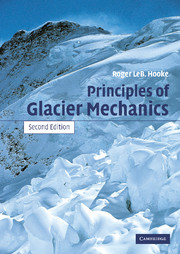Book contents
- Frontmatter
- Contents
- Preface to the first edition
- Preface to the second edition
- Physical constants relevant to ice
- Derived SI units and conversion factors
- 1 Why study glaciers?
- 2 Some basic concepts
- 3 Mass balance
- 4 Flow and fracture of a crystalline material
- 5 The velocity field in a glacier
- 6 Temperature distribution in polar ice sheets
- 7 The coupling between a glacier and its bed
- 8 Water flow in and under glaciers: geomorphic implications
- 9 Stress and deformation
- 10 Stress and velocity distribution in an idealized glacier
- 11 Numerical modeling
- 12 Applications of stress and deformation principles to classical problems
- 13 Finite strain and the origin of foliation
- 14 Response of glaciers to changes in mass balance
- Appendix: Problems
- References
- Index
13 - Finite strain and the origin of foliation
Published online by Cambridge University Press: 24 November 2009
- Frontmatter
- Contents
- Preface to the first edition
- Preface to the second edition
- Physical constants relevant to ice
- Derived SI units and conversion factors
- 1 Why study glaciers?
- 2 Some basic concepts
- 3 Mass balance
- 4 Flow and fracture of a crystalline material
- 5 The velocity field in a glacier
- 6 Temperature distribution in polar ice sheets
- 7 The coupling between a glacier and its bed
- 8 Water flow in and under glaciers: geomorphic implications
- 9 Stress and deformation
- 10 Stress and velocity distribution in an idealized glacier
- 11 Numerical modeling
- 12 Applications of stress and deformation principles to classical problems
- 13 Finite strain and the origin of foliation
- 14 Response of glaciers to changes in mass balance
- Appendix: Problems
- References
- Index
Summary
Suppose one were to drop a deformable sphere into the accumulation area of a glacier. As the sphere became buried deeper and deeper in the glacier, it would be deformed by the flow. Because the accumulation area is normally an area of longitudinal extension and vertical compression, it would become an ellipsoid, elongated in the direction of flow and compressed vertically. If there were also significant transverse compression it would become a prolate ellipsoid, whereas if there were transverse extension, it would become oblate. Figure 13.1 illustrates schematically, in two dimensions, how the shape of a cross section through the sphere would change as the sphere passed through the glacier.
Our objective in this chapter is to discuss the cumulative deformation experienced by ice as it is advected through a glacier, and to show the relation between this deformation and the banded structure, called foliation, that is characteristic of glaciers.
The strain ellipse
The ellipsoid we have just discussed is called the strain ellipsoid or, in two dimensions, the strain ellipse. Following normal convention, we will denote the greatest, intermediate, and shortest principal semi-axes of the ellipsoid by subscripts 1, 2, and 3, and the directions of these axes by X, Y, and Z, respectively. These axes will rotate with respect to our fixed x, y, z coordinate system as the strain ellipsoid rotates (Figure 13.2). The lengths of the axes of the ellipsoid are a measure of the strain it has experienced.
- Type
- Chapter
- Information
- Principles of Glacier Mechanics , pp. 349 - 364Publisher: Cambridge University PressPrint publication year: 2005



